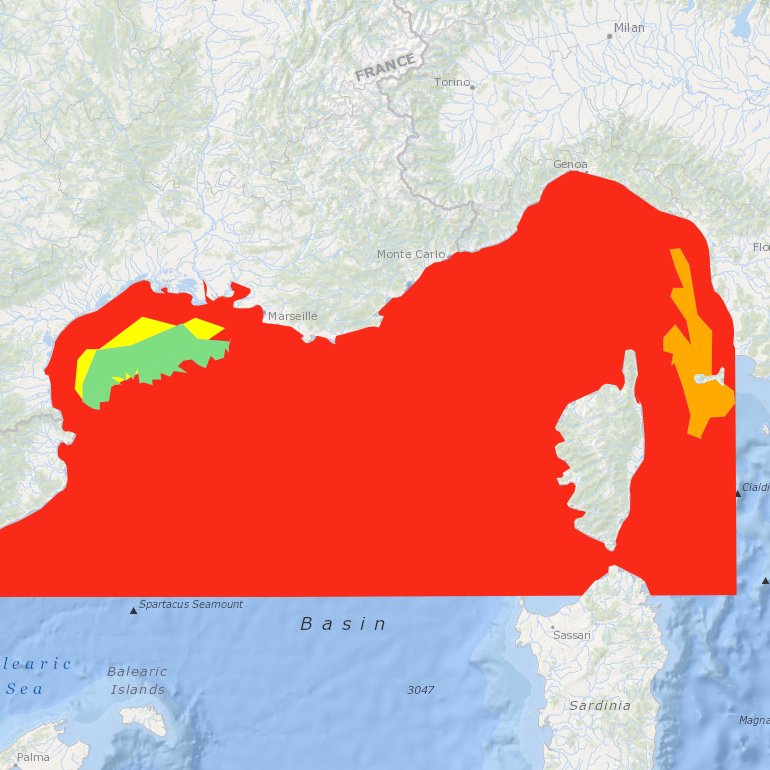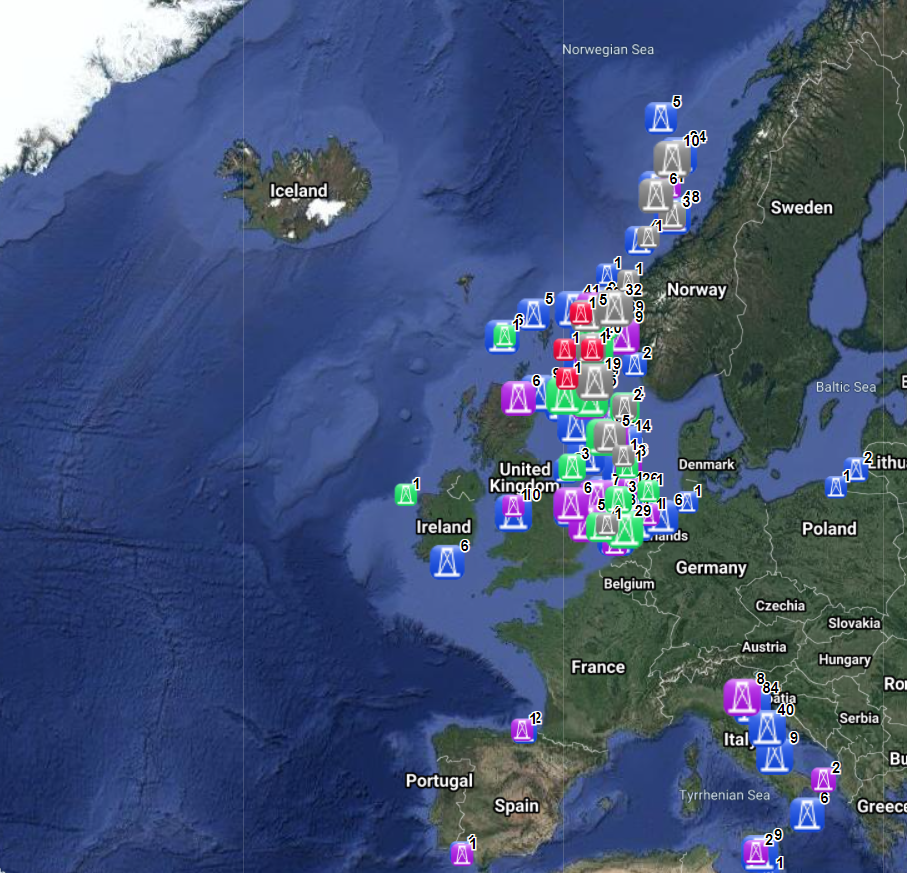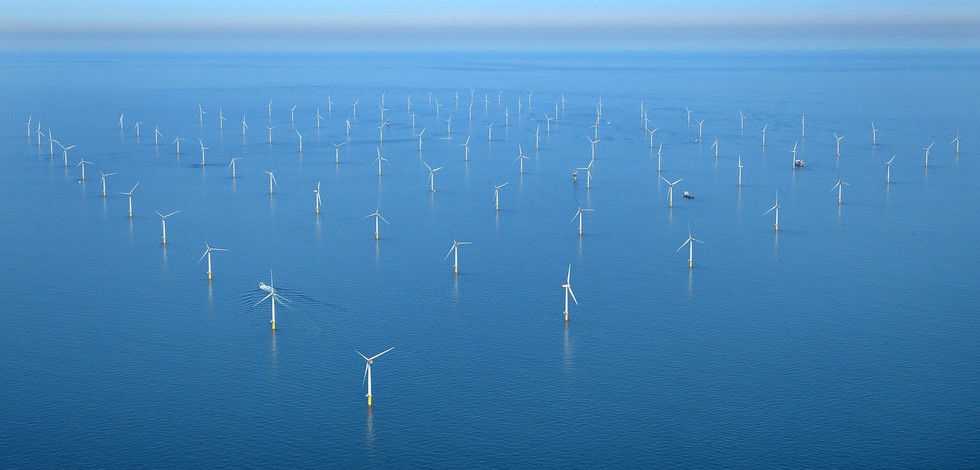Energy resources
Type of resources
Available actions
Topics
Keywords
Contact for the resource
Provided by
Years
Formats
Representation types
Update frequencies
status
Scale
Resolution
-
Suitability index of a wind farm in the NWMed concerning the environmental resources, the natural barriers, human activities, MPA and fisheries.
-
The main aim of this product was to define the suitability of offshore sites in the area between the borders of France-Spain-Italy for wind farm development. The adopted approach classifies wind speed data by their level of suitability, ranging from a grade 5 for exclusion zones, to a grade 1 for areas deemed appropriate for wind farm development. The quality indexes adopted were based on mean and variation statistical measures taking into consideration both the expected energy potential and the corresponding variability.
-
The three digital maps provided in this product aim to assess the degree of Offshore windfarm siting suitability existing over a geographical area with a focal point where waters of France and Spain meet in Biscay Bay on 500 m depth. The maps display respectively the spatial distribution of the average and lowest windfarm siting suitability scores along with the average wind speed distribution over a time period of 10 years. They are part of a process set up to assess the fit for use quality of the currently available datasets to support a preliminary selection of potential offshore sites for wind energy development. To build these maps, GIS tools were applied to several key spatial datasets from the 5 data type domains considered in the project: Air, Marine Water, Riverbed/Seabed, Biota/Biology and Human Activities, collated during the initial stages of the project. Initially, each selected dataset was formatted and clipped to the study area extent and spatially classified according to suitability scores, to define raster layers with the variables depicting levels of current anthropogenic and environmental spatial occupation of activities, seabed depth and slope, distances to shoreline, shipping intensity, mean significant wave height, and substrate type. These pre-processed layers were employed as inputs for applying a spatial multi-criteria model using a wind farming suitability classification based on a discrete 5 grades index, ranging from Very Low up to Very High suitability. In adition to suitability maps, an average wind speed spatial distribution map for a 10 years period, at 10 m height, was obtained over the study area from the raster processing of a wind speed time series of monthly means available from daily wind analysis data. The characteristics of the datasets used in this exercise underwent an appropriateness evaluation procedure based on a comparison between their measured quality and those specified for the product. The study area, located in the Biscay Golf includes a coastal zone of Spain and France. Consequently, some zones are subject to constraints to offshore windfarm implementation due to environmental protection, visual impacts and seafoor attributes. Data gaps exist with an emphasis on fishing activity and distribution of essential habitats and species. All the spatial information made available in these maps and from the subsequent appropriateness analysis of the datasets, contributes to a clearer overview of the amount of public-access baseline knowledge currently existing for the North Atlantic basin area.
-
The three digital maps provided in this product aim to assess the degree of Offshore windfarm siting suitability existing over a geographical area with a focal point where waters of France and Spain meet in Biscay Bay on 500 m depth. The maps display respectively the spatial distribution of the average and lowest windfarm siting suitability scores along with the average wind speed distribution over a time period of 10 years. They are part of a process set up to assess the fit for use quality of the currently available datasets to support a preliminary selection of potential offshore sites for wind energy development. To build these maps, GIS tools were applied to several key spatial datasets from the 5 data type domains considered in the project: Air, Marine Water, Riverbed/Seabed, Biota/Biology and Human Activities, collated during the initial stages of the project. Initially, each selected dataset was formatted and clipped to the study area extent and spatially classified according to suitability scores, to define raster layers with the variables depicting levels of current anthropogenic and environmental spatial occupation of activities, seabed depth and slope, distances to shoreline, shipping intensity, mean significant wave height, and substrate type. These pre-processed layers were employed as inputs for applying a spatial multi-criteria model using a wind farming suitability classification based on a discrete 5 grades index, ranging from Very Low up to Very High suitability. In adition to suitability maps, an average wind speed spatial distribution map for a 10 years period, at 10 m height, was obtained over the study area from the raster processing of a wind speed time series of monthly means available from daily wind analysis data. The characteristics of the datasets used in this exercise underwent an appropriateness evaluation procedure based on a comparison between their measured quality and those specified for the product. All the spatial information made available in these maps and from the subsequent appropriateness analysis of the datasets, contributes to a clearer overview of the amount of public-access baseline knowledge currently existing for the North Atlantic basin area.
-

Suitability index of a wind farm in the NWMed concerning the environmental resources, the natural barriers, human activities, MPA and fisheries.
-
The main aim of this product was to define the suitability of offshore sites in the area between the borders of France-Spain-Italy for wind farm development. The adopted approach classifies wind speed data by their level of suitability, ranging from a grade 5 for exclusion zones, to a grade 1 for areas deemed appropriate for wind farm development. The quality indexes adopted were based on mean and variation statistical measures taking into consideration both the expected energy potential and the corresponding variability.
-

-

The dataset on offshore installations for Oil and Gas exploitation and exploration activities was created in 2015 by Cogea for the European Marine Observation and Data Network (EMODnet). It is the result of the aggregation and harmonization of datasets provided by several EU and non-EU sources. It is updated every year, and is available for viewing and download on EMODnet - Human Activities web portal (www.emodnet-humanactivities.eu). The dataset contains points representing offshore installations and where available each point has the following attributes: ID, name, country, location block, operator, production start year, primary production, current status, category and function of the installation, sub-structure and topside weights (tonnes), water depth (metres), distance to coast (metres) and remarks. The OSPAR commission source covers data for Germany, Ireland, Spain and the United Kingdom, while for Italy data have been collected and harmonized from the Italian Ministry of Economic Development, for Norway from the Norwegian Petroleum Directorate, for Denmark from the Danish Energy Agency, for the Netherlands from the TNO - Geological Survey of the Netherlands, for Croatia from the Croatian Hydrocarbon Agency, from Marine Traffic and Helcom data on Polish and Russian installations in the Baltic Sea, from Marine Traffic data on Bulgarian, Russian and Ukrainian installations in the Black Sea, Lybian and Spanish installations in the Mediterranean Sea. Compared with the previous version this new version has been updated for all countries.
-

-

 Catalogue PIGMA
Catalogue PIGMA